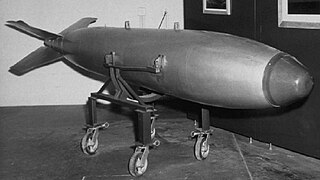Loading AI tools
From Wikipedia, the free encyclopedia
The Mark-12 nuclear bomb was a lightweight nuclear bomb designed and manufactured by the United States which was built starting in 1954 and which saw service from then until 1962.
This article needs additional citations for verification. (January 2021) |

The Mark-12 was notable for being significantly smaller in both size and weight compared to prior implosion-type nuclear weapons. For example, the overall diameter was only 22 inches (56 cm), compared to the immediately prior Mark-7 which had a 30 inches (76 cm) diameter, and the volume of the implosion assembly was only 40% the size of the Mark-7's.
There was a planned W-12 warhead variant which would have been used with the RIM-8 Talos missile, but it was cancelled prior to introduction into service.

The complete Mark-12 bomb was 22 inches (56 cm) in diameter, 155 inches (3.94 m) long, and weighed 1,100 to 1,200 pounds (500 to 540 kg). It had a yield of 12 to 14 kilotonnes of TNT (50 to 59 TJ).
The Mark-12 has been speculated to have been the first deployed nuclear weapon to have used beryllium as a reflector-tamper inside the implosion assembly (see nuclear weapon design). It is believed to have used a spherical implosion assembly, levitated pit, and 92-point detonation.
Though the weapon went out of service in 1962, it resurfaced in a fictional role in Tom Clancy's 1991 book The Sum of All Fears and the 2002 film, where the plot included an Israeli copy of the Mark-12 being lost by accident in 1973 during the Yom Kippur War in southern Syria near the Golan Heights, and then recovered by a terrorist organization.[1]
Seamless Wikipedia browsing. On steroids.
Every time you click a link to Wikipedia, Wiktionary or Wikiquote in your browser's search results, it will show the modern Wikiwand interface.
Wikiwand extension is a five stars, simple, with minimum permission required to keep your browsing private, safe and transparent.